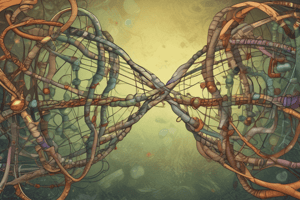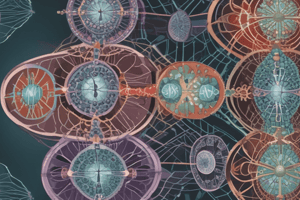Podcast
Questions and Answers
What does DNA represent in terms of genetics?
What does DNA represent in terms of genetics?
The blueprint for controlling the characteristics of organisms.
How is genetic information passed to offspring?
How is genetic information passed to offspring?
Through meiosis and fertilization.
What is a characteristic of Mendelian inheritance?
What is a characteristic of Mendelian inheritance?
- It does not involve any genetic variation.
- It is only applicable to animals.
- It can involve dominant and recessive traits. (correct)
- It involves only one parent.
What factors contribute to mutations?
What factors contribute to mutations?
Which descriptor pertains to the assessment of biological sciences?
Which descriptor pertains to the assessment of biological sciences?
What are chromosomes?
What are chromosomes?
What process describes the inheritance of a dominant/recessive trait through generations?
What process describes the inheritance of a dominant/recessive trait through generations?
What is the role of DNA?
What is the role of DNA?
Which processes contribute to the passing of genetic information to offspring?
Which processes contribute to the passing of genetic information to offspring?
What do dominant and recessive characteristics refer to?
What do dominant and recessive characteristics refer to?
Mutations are changes in DNA or chromosomes.
Mutations are changes in DNA or chromosomes.
What factors contribute to mutations?
What factors contribute to mutations?
Flashcards are hidden until you start studying
Study Notes
Somerville House Science Exam
- The exam is for Year 9 Science students.
- The exam is an in-class exam.
- The exam is worth 50 marks.
- The exam is on Unit 1: Biology.
- The exam is on Topic 1: Genetics and Patterns of inheritance.
- The exam lasts 70 minutes.
- The exam includes multiple choice questions and short answer questions.
Australian Curriculum Descriptors
- The exam assesses ACSSU 184, which covers the transmission of heritable characteristics from one generation to the next.
- Students will need to demonstrate an understanding of DNA as the blueprint for controlling the characteristics of organisms.
- Students will need to use models and diagrams to represent the relationship between DNA, genes, and chromosomes.
- Students will need to recognize that genetic information passed on to offspring is from both parents by meiosis and fertilization.
- Students will need to represent patterns of inheritance of a simple dominant / recessive characteristic through generations of a family.
- Students will need to predict simple ratios of offspring genotypes and phenotypes in dominant / recessive gene pairs (sex-linked = extension only).
- Students will need to describe mutations as changes in DNA or chromosomes and outline the factors that contribute to mutation.
Science as a Human Endeavor
- The exam may also assess aspects of Science as a Human Endeavor, but the specific details are not provided in the text.
Year 9 Science - Unit 1: Biology
- In-class exam focused on Genetics and Patterns of Inheritance
- Assessment objectives cover ACSSU 184: Transmission of heritable characteristics from one generation to the next involves DNA and genes
- Total marks: 50
Topics covered in assessment:
- DNA as the blueprint for controlling the characteristics of organisms:
- Key functions of DNA:
- Holds genetic information that determines traits
- Acts as a blueprint for an organism's development and functioning
- Passed on to offspring from both parents
- Key functions of DNA:
- Relationship between DNA, genes and chromosomes:
- Chromosomes: Long strands of DNA
- Genes: Specific segments of DNA located on chromosomes
- DNA: Contains the instructions for building and maintaining an organism
- Role of meiosis and fertilisation in passing on genetic information:
- Meiosis: Cell division process to produce genetically unique gametes (sex cells)
- Fertilisation: Fusion of male and female gametes, combining DNA from both parents
- Patterns of inheritance of a simple dominant/recessive characteristic:
- Dominant trait: One copy of the gene is enough for the trait to be expressed
- Recessive trait: The trait is only expressed if two copies of the gene are present
- Examples can be used to predict offspring genotypes and phenotypes
- Mutations:
- Changes in DNA or chromosomes: Alterations in the genetic code
- Factors contributing to mutations:
- Environmental factors
- Exposure to radiation
- Errors during DNA replication
Studying That Suits You
Use AI to generate personalized quizzes and flashcards to suit your learning preferences.




